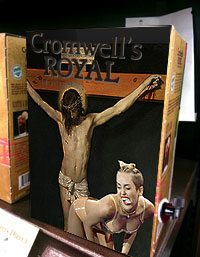
Seagram's V.O. was created in 1914 when Joseph Seagram's son Thomas asked distiller William Hortop for a special cask for his upcoming wedding. Hortop created a custom blend. The whisky was so good that Seagram decided to launch it as a new expression, according to Davin DeKergommeaux in "
Canadian Whisky, a portable expert". (the link there takes you to the Amazon page for the book.) My review of that book is here:
http://www.cooperedtot.com/2012/06/canadian-whisky-portable-expert-by.html
Seagram's V.O.hit the market in 1917 and has been huge, pretty much, ever since. In the book, Davin doesn't speculate on what "V.O." means. There are two conventional speculations - with no evidence at all to choose between them:
1) V.O. stands for "Very Own" - because it was a special blend crafted for Thomas' "Very Own".
2) V.O. stands for "Very Old" and was an attempt to reference Cognac's V.S. designation.
I won't bother to speculate either except to note that V.O. is always given with periods on bottle shots and ads from Repeal through the 1980s. Yet the current bottling and recent ads omit the periods. When, exactly this happened, and why, I have no idea. I use periods or not depending on which era's bottling I'm discussing.
Originally V.O. was made at Seagram's Waterloo distillery and was 10 years old, according to DeKergommeaux (whose authority I accept). In my poking around I haven't encountered a label or an ad ever with a 10 year age statement. Please let me know if you see one! The earliest labels I can find date to the late 1920s and already show the 6 year age statement that is standard for the whole sweep of VO's history, with the exception of the final year or two of World War II when it was 7 years old. Well... the probable earliest label I can find is all messed up, actually, with no proof statement, no age statement, and an apparently incorrect designation of V.O. not as a blend at all, but as a "Pure Rye":
 |
Early (probably 1920s) 2oz. mini bottle lacks age statement but does specify "pure rye".
Photo from http://www.pre-pro.com/ |
Is this mini bottle real evidence that V.O. once was a "Pure Rye" instead of a blend? Probably not. In any case, the provenance is unknown. It may be a fake. It may be an error. Or it may truly be a significant varient. It poses more questions than it answers.
 |
This 1928 full bottle specifies "Blended"
Photo from whiskyvault.com |
This 1928 label shows the basic constellation of features of Seagram's V.O. for half a century. It is, however, also missing both an age statement and a proof statement, but this 1936 ad shows the bottle and gives both: an 86.8 proof statement and a big red "6" on the lower label:
 |
| This 1936 ad shows the 20s-30s bottle style and specifies 86.8 proof. |
There appears to have been a 7 year age statement version in the WWII years. I've seen ads for 7 year old age statement V.O. in the years '42, and '44.. Let me know if you know of other years. Here's how I can show it: Here are a trio of ads that bracket a period when Seagram's V.O. advertised the 7 year old age statement - showing how 7 and 6 year age statement editions of the same brand went in and out during this period. Ads from 1943 and 1946 which show the 6 year age statement flank a 1944 one that trumpets 7 years old:
 |
By 1943 we see the new label, used up until the late '90s with the 6 year age statement
and the 86.8 proof strength statement. |
 |
| In this 1944 ad we see a 7 year age statement, both in the ad's text and on the bottle. |
 |
| But by 1946, a scant two years later it's back to 6 years again. Apparently for good. |
That 1946 ad is a wonderful bit of nostalgia today. The Sci-Fi "New wonders of speech and writing devices by Men who Plan beyond Tomorrow" include two refinements to telegram technology: a phone that spits out telegrams (at bottom) and a curbside telegram machines (at right). At left there are some very forward looking radio phones that presaged cell phones. At top we have a typing dictation machine. While the likes of Dragon Naturally Speaking and Siri have made this a reality, it's still in its infancy, so this particular item was quite forward thinking indeed.
One thing is for sure, Seagram's V.O. was very popular through Repeal and WWII and on through the Mad Men era. Why was it so popular? Probably for many of the same reasons rye whisky in general had been popular from Colonial days on: the herbal spicy flavor tastes like whisky to a ton of people. V.O. brought the Canadian refinements of smoothness, sweetness, and consistency through the particularly advanced Canadian art of blending and extensive use of refill casks. This gives V.O. a light and smooth aspect that appeals to a lot of people. V.O. is the jewel in the crown for Seagram's Corporation on through this whole long period. A titan.
Seagrams, under Sam Bronfman, moved production of V.O. from Waterloo to Amherstberg, Ontario in the mid 1940s. In the late 1960s a more modern distillery was built at Gimli and production was moved there. When Diageo took over in 2001 they shifted the bulk of VO's production to Valleyfield. But, as VO is a blend of multiple whiskies, exact distillery provenance is difficult to pin down. Parts of VO still come from Gimli. And in the 60s, parts of V.O. may have still came from Waterloo.
For this tasting I have sourced a 200ml flask of current production Seagrams VO from a train station liquor store nearby. To give insight into the pre-Gimli flavors, a 1971 tax stamped airline bottle was sourced from a German auction house.
Seagram's VO 40% abv. Current production
No visible age statement. Base whiskies distilled at Valleyfield. Some flavoring whiskies may still come from Gimli.
Color: pale gold.
Nose: Creamy white vanilla fudge, mineral dust, some gentle cedar forest aromas, and grapefruit pith.
Palate: Creamy and sweet on opening. The vanilla fudge sweetness is here, but gives way to rye spice and herbal and mineral notes along with rye heat and spirit heat on the expansion. The spirit heat moment at the mid-palate is why VO is typically used as a mixer - but frankly this sips quite nicely as a Canadian blend with all the classic aspects of the Canadian whisky flavor signature. The turn to the finish is asserts a slight astringency and ushers in the flavors of grapefruit peel pith that wax sweet and creamy again in the moderately short finish. It's surprisingly sippable for the price. On the whole, I was impressed. I was expecting a 2 star mixer but on the balance I'd say it's a 3 star entry level sipper.
***

Seagram's V.O. 43.4% abv. 1971-1976
6 years old. The tax strip says 1971 which is the year of distillation.
Amherstberg, with some components perhaps coming from Waterloo, Ontario. No proof statement on the bottle. Also, interestingly, no volume statement either.
Color: pale gold
Nose: Sharper, with a clear sweet vanilla floral opening. Deeper there are notes of fruity bitter hops and classic herbal rye sweet and spice notes. The extra proof is readily apparent in the nose too: spirit burn.
Palate: The entry is sweet, with cream and cereal sugars, but is much drier than the vanilla fudge opening in the current version. Rye shows up as floral herbal flavors of rye grain and, cilantro and cut ivy. Herbal rye with some real intensity and chili scented spicy kick are all over the mid-palate too, which carries some of the effervescent mouth feel you get with pure rye whiskies. There is the hops-like bitterness of rye's turn melding into the fruity bitter grapefruit pith flavor note. The bitterness hangs on with sharpness and vividness through the rather long finish.
This is a different animal; one much closer to a high end rye whisky. The flavors are vivid. Well delineated and embedded in a matrix of rye and corn that balance sweetness and dryness. The main rap is that it's hot - but that's tot unusual for good rye whiskies.. But this is clearly a sipper and pretty nice one.
*****
If there's no proof statement, how do I know the 1971 example is 86.8 proof? Ads for V.O. show 86.8 proof at least through 1985. The lowering of the proof happened after that - probably in the 90s. As evidence I'll leave you with this lovely 1973 ad which displays 86.8 proof and helps put this bottling in a cultural context:
 |
Seagram's V.O. 1973 ad. - an elegant bit of 70s design.
A tinge of feminism? The woman takes the lead on the slope and is the clear
sexual aggressor in the apres-ski which is all about highballs.
Notice that she also has a much larger drink than he does too. |
So what can we conclude? The older version is better. Why? There are several obvious factors: now, the age statement is gone allowing younger whiskies to be used; the proof has been lowered from 86.8 to 80 (pretty close to 10%). Bottle maturation may be making an appearance improving the sweetness and intensity of flavors in the 1971 bottling (which has 42 years in the glass). And, of course, the distillery was changed not once but twice between the two samples. There are too many factors changing and not enough data points here to draw any conclusions. Except this one: Seagram's V.O. was a popular whisky for years because it was a pleasurable flavor signature that people drank neat, with water, ice, and in cocktails. With the reduction in quality VO mainly plays in mixer-land, but it still retains a big chunk of what once made it a titan. It's one of those whiskies you can enjoy neat that you can acquire at an attractive price point ($15 for a 750ml bottle). The kind you're likely to find at selection-challenged lesser bars where you want to get a whisky. I recommend having a taste and you may find it joins your arsenal of "basic options". I was certainly pleasantly surprised with both the interesting dusty mini but also the "plain Jane" new stuff too. .



 The palate of the combo emphasizes the odd and unexpected planes of their union: floral and sweet without being sugared. The sweetness is a mass of heavy massed tropical floral notes and tons of zing (stealth ginger). The spices - the cloves, mace, and cinnamon - ride around in a big car made of malt whisky stone fruits made zingy - like raspberry. Tasting it you'd never guess there were only two ingredients. It likes some water - or even better - some ice. This has joined my regular rotation. It puts a vinous overlay over the whisky in a way that reminds me of a Manhattan, but with a totally new and very Caribbean flavor set. This pairing has come to named "The Last Call". It's a drink with a future. It also likes a few drops of orange water or citrus bitters - but my favorite is neat, 2/3 plus a drop of Brenne and slightly less than 1/3 Sorel. Just magic.
The palate of the combo emphasizes the odd and unexpected planes of their union: floral and sweet without being sugared. The sweetness is a mass of heavy massed tropical floral notes and tons of zing (stealth ginger). The spices - the cloves, mace, and cinnamon - ride around in a big car made of malt whisky stone fruits made zingy - like raspberry. Tasting it you'd never guess there were only two ingredients. It likes some water - or even better - some ice. This has joined my regular rotation. It puts a vinous overlay over the whisky in a way that reminds me of a Manhattan, but with a totally new and very Caribbean flavor set. This pairing has come to named "The Last Call". It's a drink with a future. It also likes a few drops of orange water or citrus bitters - but my favorite is neat, 2/3 plus a drop of Brenne and slightly less than 1/3 Sorel. Just magic.









































